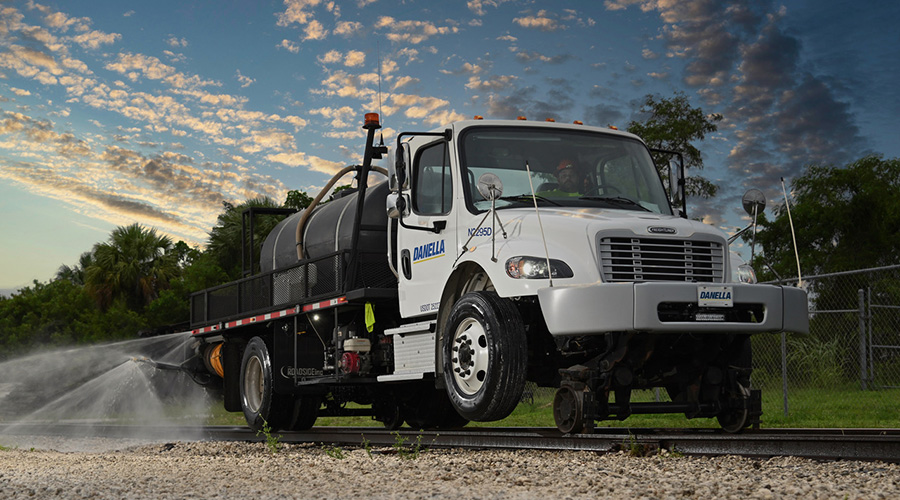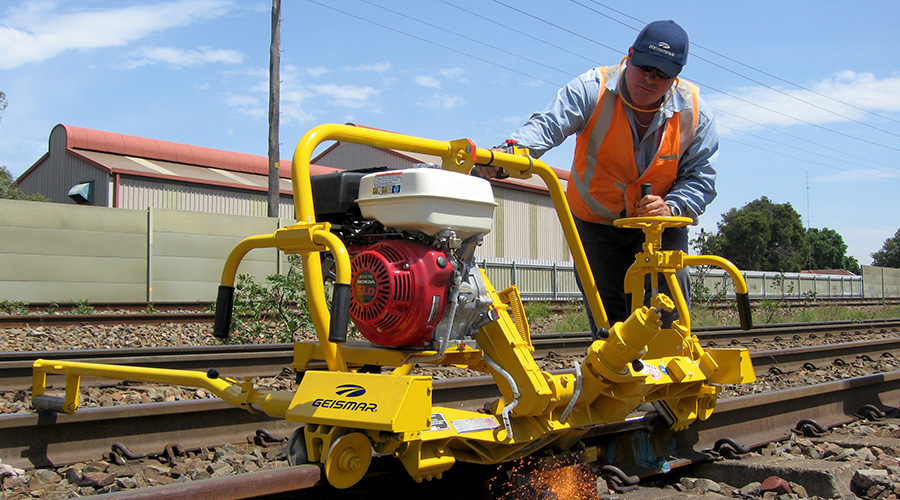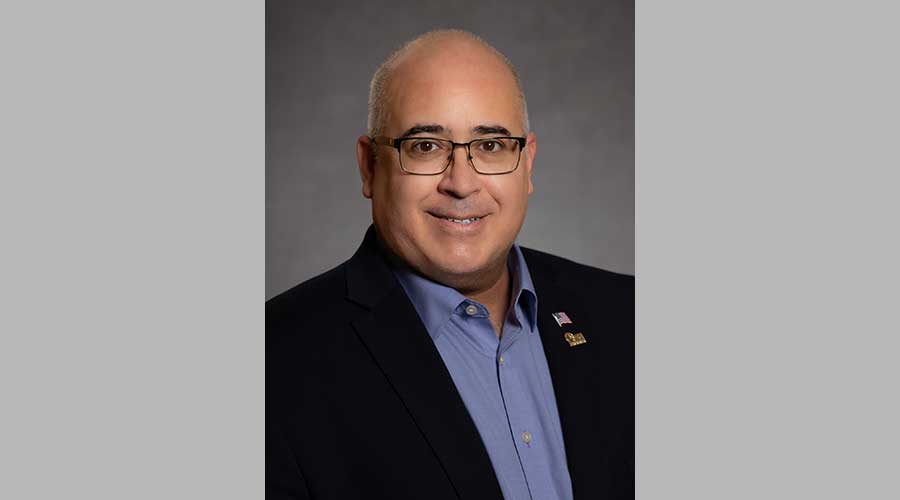Stay updated on news, articles and information for the rail industry
November 2011
Rail News: MOW
Maintenance of way: Rail grinding equipment update
By Angela Cotey, Associate Editor
With track time almost always at a premium, railroads’ expectations for nearly any type of maintenance-of-way equipment remains the same: fast machines that get the job done as efficiently as possible.
During the past several years, grinding equipment suppliers have fine-tuned their equipment to meet railroads’ need for speed. Average speeds of production grinders between 2005 and 2011 have increased from about 6 mph to 7 mph to 9.5 mph or 10.5 mph, says Dereck Bartz, product manager-rail grinding for Harsco Rail.
Suppliers are addressing the efficiency issue, as well. Production grinding equipment manufacturers are coupling their upgraded, more powerful machines with inspection vehicles to enable railroads to shave off the proper amount of metal. Specialty grinding equipment suppliers are trying to develop smarter, faster machines, as well, and are incorporating safety and comfort features that benefit the operators. The efforts play into railroads’ push to improve both equipment and worker productivity, suppliers say.
“Today, when you look at technology as it relates to the market, a lot of the conversation really centers around measuring and analysis and planning,” says Bartz. “These are substantial machines and track time is at a premium … so to utilize that machine in the most efficient manner, that’s what the market is really looking for.”
To that end, Harsco is coupling its grinders with a new machine developed by Harsco Rail business unit ZETA-TECH. The Automated Switch Inspection Vehicle (ASIV) is designed to analyze rail profiles and determine grinding machine patterns in real time.
“The ASIV gives us very high-density rail projections that allow us — before the grinder even gets to its destination — to determine how fast the machine can grind, what sort of metal removal it should do and the orientation of the motors,” says ZETA-TECH Senior Director of Engineering and Technology Joseph Palese.
By marrying the projections taken by the ASIV with a Harsco production or switch and crossing grinder, railroads will be able to obtain exact measurements, Harsco officials say.
“In the past, we’ve always identified what the rail shape should look like using hand gauges and rail profile systems, and those are onboard the grinder,” says Palese. “We’re trying to improve the life of the rail by making the machine take off exactly the right amount of metal — not too much, not too little — so that we can control those rates, get rid of micro-cracks and control the wheel-rail interface.”
Harsco continues to offer its RMS-series production grinders, which have been upgraded during the past five years.
“They’ve become more powerful, with higher horsepower, and the control system is much more comprehensive,” says Bartz.
Loram: Raising its bar
Loram Maintenance of Way Inc. introduced a faster, more powerful grinder last year — the RG400 Series.
“Norfolk Southern Railway was the first railroad to begin using the RG400 Series Production Rail Grinder,” says Loram Manager of Marketing and Business Development Joseph Ashley. “These grinders range in size from 90 to 120 grinding stones.”
Canadian Pacific, CSX Transportation and BNSF Railway Co. now are using the grinders, as well.
“The 400 series is the biggest investment our company has ever made in the development of rail grinders,” says Ashley. “We took everything that was good about our existing fleet and developed even more features.”
In addition to offering higher operating speeds, the new grinders feature an improved dust collection system designed to meet the latest U.S. Environmental Protection Agency requirements and a higher-capacity water car that can hold up to 25,000 gallons of water, allowing the grinder to carry up to 75,000 gallons of water for improved fire suppression. The RG400 Series also features better fuel efficiency.
“We’re seeing a 15 percent reduction in fuel cost,” says Ashley.
Like Harsco, Loram is pairing its production grinders with a rail inspection vehicle that creates an accurate grind plan, which helps railroads develop a preventive grinding strategy — something Loram officials have been trying to persuade railroads to adopt.
“We’re starting to see better rail life extension through more exact rail grinding,” says Ashley.
Vossloh Rail Services GmbH focuses on preventive grinding technology, as well. Since 2007, Vossloh has offered high-speed grinding (HSG) trains in Europe that can operate at speeds up to 55 mph.
“It’s very unique, because it enables us to work within the normal traffic schedule,” says Vossloh Vice President of Sales and Marketing Marcel Taubert. “We’re not blocking traffic because it runs like a regular train.”
The company is in the process of launching a second-generation HSG train in Europe and hopes to begin offering a HSG train in North America in 2012, says Taubert.
“We are now in discussions with some Class I railroads to introduce this train to their most frequented rail networks,” he says.
Finding a niche
To do so, Vossloh will need to adapt its European product for the American market by tweaking the optimized spot suppression system and equating the range of the grinding train with some modified grinding stones, says Taubert. Given railroads’ tight track windows, Vossloh officials believe there will be high demand for the high-speed machine. However, Taubert acknowledges the HSG train won’t work for all railroads or on all lines.
“We are aware that, even for the Class Is, we are a niche service provider, and our niche is their most densely used tracks,” he says.
Other grinding equipment suppliers are trying to fill a different kind of niche. As railroads demand faster, more efficient and more powerful production grinders, they’re seeking the same from specialty grinders.
To that end, Loram recently introduced the RGS Specialty Gap Grinder. The first model, the RGS1, is a 24-stone grinder, but the platform can accommodate up to 48 stones, says Ashley.
“The RGS is built off the same platform as our production grinders, so they have the same power and features, but with the flexibility to grind specialty trackwork, like switches and crossings,” he says. “We’re seeing switches ground in half the time of our traditional specialty equipment, and that falls along the lines of getting more done in the available track window.”
Modern Track Machinery Inc. is offering a new specialty grinder, too. About 18 months ago, the company introduced the MP23 profile grinder, which is designed to grind the whole profile of flat bottom rails in one operation.
The machine features an ergonomic design that enables the operator to stand upright while the grinder rotates within its frame, says General Sales Manager Al Reynolds.
“Normally, the machine is on the side and the operator has to adjust to where he can stay stationary, so this is good for both safety and ergonomic purposes,” he says.
The MP23 also enables an operator to preset a stop to prevent overgrinding and dips on thermit or in-track welds.
“We’re taking some of the human judgment out of it and allowing the machine to keep from grinding beyond where it needs to go,” says Reynolds.
Modern Track Machinery also offers the MC-3A, which can grind frogs, switch points and stock rails.
On the spot
Meanwhile, Railtech Matweld Inc. offers a line of hydraulically powered grinders that primarily are used for spot maintenance and small repair jobs. Models include hand-held straight stone, cup stone, lightweight profile, multi-purpose and precision frog grinders.
The multi-purpose grinder enables the operator to stand straight up while grinding, which helps prevent back fatigue, according to Matweld. The company’s latest product, the precision frog grinder, also is designed so operators can stand upright. In addition, the machine “allows for all operators to produce the same result when repairing frogs,” the company said in an email.
Railroads take into account such speed, productivity and safety issues when choosing a grinding machine, be it of the specialty or production variety. As freight-rail traffic continues to grow — therefore putting more stress on track — railroads will continue stepping up efforts to maintain their networks. That trend bodes well for grinding equipment suppliers.
“Railroads are spending more time maintaining their track,” says Reynolds, referring specifically to switches, though the comment could just as easily apply to mainline track or other specialty trackwork. “Track material is very expensive these days, and to extend the life of it, railroads will go out and maintain it rather than replace it, and the grinder pays for itself in a very short time.”
Email comments or questions to Angela Cotey.
Keywords
Browse articles on rail grinding grinding equipment maintenance of wayContact Progressive Railroading editorial staff.


 2025 MOW Spending Report: Passenger-rail programs
2025 MOW Spending Report: Passenger-rail programs
 Gardner steps down as Amtrak CEO
Gardner steps down as Amtrak CEO
 Guest comment: Oliver Wyman’s David Hunt
Guest comment: Oliver Wyman’s David Hunt
 Women of Influence in Rail eBook
Women of Influence in Rail eBook
 railPrime
railPrime






